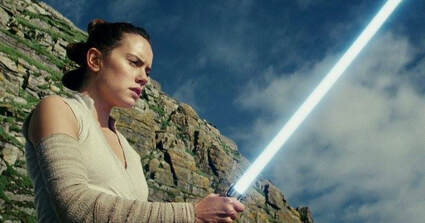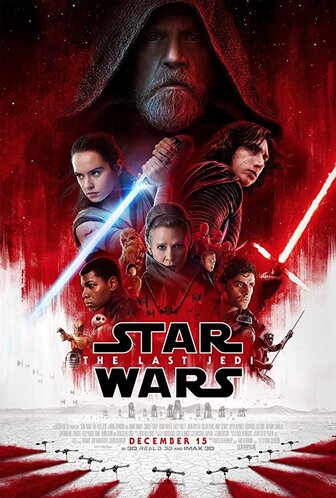Written by Joel T. Lewis The brilliance of Rian Johnson’s latest installment in the grandest of movie franchises is difficult to put into words. Is it a perfect film? Far from it. Is it a true Star Wars film? What the hell does that even mean? One thing is clear about this installment: It doesn’t care what you think Star Wars is, or should be. And that’s incredibly ambitious, and ultimately successful. We spent 2 years agonizing about who Snoke is, who Rey’s parents are, and what Luke has been doing this whole time, and Rian’s response to the Star Wars fan tendency to speculate was to undermine every assumption we made. It doesn’t matter who Snoke was because he’s dead now, Rey is a nobody sired by nobodies, and Luke doesn’t live up to the legend we’d built him up to be even to himself. What we’re left with is the powerful theme of learning from failure, the more developed and nuanced conflict between Kylo Ren and Rey, and the desperation of a new Rebellion. I’ve always speculated about how things played out in the Star Wars Universe. I’ve debated for hours over the origin of Blue Milk, what fuels the economy of Tatooine, and how Jar Jar (yes Jar Jar) knows what the currency Wuipiupi is in Episode 1, but it was never with the knowledge that at some point down the line I would get any answers. Sure there were the Expanded Universe books before the canon shake-up and the Prequels filled in some blanks that we never wanted filled in, but until the credits rolled on Force Awakens, whatever speculation we had about what happened after Return of the Jedi had been completely hypothetical. Where we are now with the Star Wars story is simply uncharted territory for us. Before we had all this time to speculate about a hypothetical future narrative that we never thought would come. Now that we have new primary sources we’ve been thrown all out of whack. Ultimately the hotshot Star Wars sensibility we’ve come to expect from these films, of Luke destroying the Death Star, Wedge Antilles and Lando destroying the second Death Star, Poe Dameron and Company destroying Starkiller base (Death Star 3), Jyn Erso and Company infiltrating Scarif to steal the plans to the Death Star, and a dozen examples in the prequels of lone Jedi tearing through battle droids or fighters taking the fate of the galaxy into their hands, is shown to be the ridiculous, vainglorious folly that it has always been. Poe’s roguish defiance gets a lot of Resistance pilots killed in the very first action sequence of the movie, and his desperate last-ditch plan that sends newcomer Rose and Finn on a momentum killing, CGI heavy wild codebreaker chase, allows the First Order to nearly eradicate the dwindling Resistance forces. The Last Jedi is all about acknowledging and ultimately rejecting the hubris that we loved to see in Han Solo, Darth Vader, Luke, the Sith, and the Jedi. This is not to the detriment of the film or the franchise!  Last Jedi is a gut check to the hubris of the speculative fan as well. By undermining the importance of Rey’s parentage and Snoke’s identity in particular, Johnson boldly asserts that this story is about Rey and Kylo, about the First Order and a newborn Rebellion, and speculate as you might, this story will not be contained by expectation or speculation. Star Wars rolls on, fanboys be damned. I’ve mostly discussed the spirit of the film, so to move on to the review proper, Episode VIII is ambitious, fun, and action-packed. With a meandering second act, a touch of choppy robotic acting (and I’m not referring to the droids here) in the first few scenes, and a few too many possible endings after the third act, Last Jedi is far from perfect but the best bits of the film are among the best in the whole of Star Wars canon. Luke, Rey, and Kylo’s storyline is beautifully executed showing how nuanced and interesting the relationship between Rey and Kylo has become, and how Luke’s failure with Ben Solo leads him to confront his apprentice one last time free of hubris. Watching Rey and Kylo dispatch a room of red-clad First Order Guards after the shocking murder of Snoke and seeing Luke and Kylo face off that final time were probably the most spectacular sequences I’ve ever seen in Star Wars (excepting the Vader scene at the end of Rogue One). Yoda’s back and better than ever, offering sage and cryptic advice once again to the disheartened Skywalker as a blue tinged force ghost. Poe has an interesting character arc as he withdraws from his hotshot pilot instincts to retreat and preserve the dramatically reduced Resistance forces. But his arc is also a problematic one as a lot of people had to die for him to learn and grow. Newcomer Rose is a great addition though again her and Finn’s subplot drags quite a bit. Finn doesn’t have a whole lot to do in this film besides a quick bout with a still incompetent Phasma who appears to die in a raging fire. This was particularly disappointing as Phasma is a character who has been woefully underdeveloped in two films now. Vice Admiral Holdo is initially frustrating but ultimately the slap of reality we needed to shake us out of our hotshot complex, and her final hour sacrifice is perhaps the most spectacular thing I’ve ever seen on the silver screen. Mark Hamill is back with a vengeance, the late great Carrie Fisher is outstanding (though Leia pulls one of the silliest force tricks ever #MaryPoppinsYall), and besides the few early awkward line deliveries I mentioned earlier the cast really shined. It’s a good movie, not without its issues, but it’s landed securely in my top three Star Wars Films list. The Star Wars universe continues to expand and grow, and I sincerely hope that Rian Johnson’s boldness in The Last Jedi ushers in a new era of films that will continue to inspire, awe, and frustrate us for many years to come. Until next time, Geek On!
0 Comments
Leave a Reply. |
Archives
November 2024
|
|
© 2012-2024, Nerds That Geek LLC.
All Rights Reserved. |
uWeb Hosting by FatCow


 RSS Feed
RSS Feed